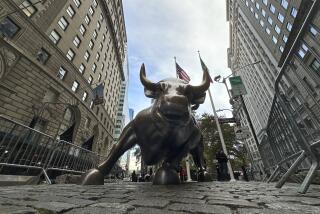Dollar Plunges to Record Lows : Stock Market Falls 76 Points on New Fears
NEW YORK — Sideswiped by the dollar’s continuing plunge on foreign exchange markets, the stock market staggered to its worst trading day in more than a month on Monday as nervous investors took cover against the prospects of another market crash.
The Dow Jones industrial average suffered its eighth-largest point loss on record--falling 76.93 points to close at 1,833.55 in the New York Stock Exchange’s 12th-busiest day ever. Broader market measures suffered similar setbacks, and about eight stocks declined for every one that rose on the Big Board.
Could Have Been Worse
But, when the day was over, investors and traders took some solace in knowing that the damage could have been far worse. In the first half-hour of trading, the Dow fell 56.37 points, and by mid-afternoon the loss had widened to 110. Analysts said that only some late-afternoon fishing for good buys saved the index of 30 blue-chip stocks from its third-worst day ever.
The magnitude but not the direction of the market surprised traders and analysts. When last week’s trading ended with a drop in the Dow, snapping a 21-year string of Thanksgiving holiday rallies, predictions were widespread that stocks would nose-dive Monday.
“This was foreshadowed on Friday,” said Hildegarde Zagorski, a market strategist for Prudential-Bache Securities in New York. “Before we even opened, we knew which direction we were headed.”
Retailers added to the gloomy picture by turning in mixed reports about their crucial post-Thanksgiving sales--a key indicator of what lies ahead for the economy, because the Friday after Thanksgiving is usually the busiest shopping day of the year.
And, to make matters worse, U.S. investors awoke to discover that the dollar’s value had sunk to post-World War II lows against the Japanese yen and the West German mark overnight amid foreign investors’ fears that the U.S. Congress won’t act quickly to rein in the federal budget deficit and that U.S. officials are content to let the dollar’s value drift.
Such declines in the dollar’s value augur higher inflation, higher interest rates and a gloomier economy at home, and they make foreign products more expensive and thus less competitive in the United States.
Market in Tailspin
The combination drew waves of sellers into the trading pits and threw the stock market into a tailspin. Traders said that many stocks opened the day fully two to four points lower than their close on Friday.
“It was the same thing--a weak dollar. When it set new lows, it set the whole thing into motion,” Zagorski observed.
Computer-driven program trading accentuated the early plunge, traders said, but had abated by mid-morning and wasn’t a big factor the rest of the day.
The broad setback rekindled the fears surrounding last month’s historic market crash--when the Dow lost a record 508 points in a single day--and evoked some predictions of more trouble ahead, although not of record-breaking magnitude.
“December is going to be a wild month,” predicted Alfred E. Goldman, a market strategist for A. G. Edwards & Sons in St. Louis. “We’ve seen a high level of complacency for two weeks, and even after today the level of fear is still very low. That’s not a good sign.”
Eugene D. Peroni, an analyst at Janney Montgomery Scott in Philadelphia, agrees. “No doubt about it, whenever we lose sight of the fact that we’re in a bear market, things begin to go sour, and we’ve been awfully complacent the last couple of weeks,” he said.
Frustration but Not Panic
Although the market was down sharply all day, not all was gloom and doom. Traders and analysts said that the financial markets were much more orderly Monday than on Oct. 19, the day of the crash, and that investors this time exhibited more frustration than panic.
“Investors were stepping out of the way much quicker” than in the days surrounding the market crash, said Edward J. Shopkorn, a strategist with the New York investment firm of Mabon, Nugent & Co. “Desperation seems to have changed to frustration; if there’s no good reason to buy, they don’t.”
Many traders and analysts predicted that investors--especially foreign investors--won’t have any reason to buy en masse again until Congress passes a federal deficit-reduction package. Congressional and White House negotiators agreed earlier this month on $76 billion in federal budget cuts over two years. But some overseas investors are said to be concerned that the full Congress won’t approve the package.
“The package is pathetic and, now that the markets have had time to study it, they know it,” Goldman said. “There is a growing concern that this Administration can’t handle its problems, and, until the perception changes, don’t expect any real buying.”
Traders saw few individual investors dumping stock Monday. Rather, they said, most of the 268.91 million shares that changed hands on the Big Board were traded in huge blocks by institutional investors trying to unload shares that they bought over the past two weeks, clean up their portfolios for year-end tax purposes or take advantage of hefty dividends from utility stocks that are going “ex-dividend” this week. Such stocks pay a quarterly dividend to the seller of the stock rather than to the buyer, so trading is often active in these stocks just before they go ex-dividend.
The Big Board’s five most active issues were all utility stocks, and all but one, Detroit Edison, goes ex-dividend today. These stocks accounted for more than 20% of the day’s volume.
Among other actively traded blue-chip stocks, International Business Machines fell $4.125 to $110.75; General Electric dropped $1.50 to $42.375; Eastman Kodak was down $2 to $45.375, and Exxon declined $2.375 to $36.75.
Broader market measures also showed deep losses. The NYSE’s composite index fell 5.47 to 129.69, and the Standard & Poor’s 500-stock composite index was down 10.04 to 230.30.
At the American Stock Exchange, the market value index closed the day at 242.39, down 8.58. And the NASDAQ composite index of over-the-counter stocks finished at 274.25, down 12.46.
More to Read
Inside the business of entertainment
The Wide Shot brings you news, analysis and insights on everything from streaming wars to production — and what it all means for the future.
You may occasionally receive promotional content from the Los Angeles Times.










